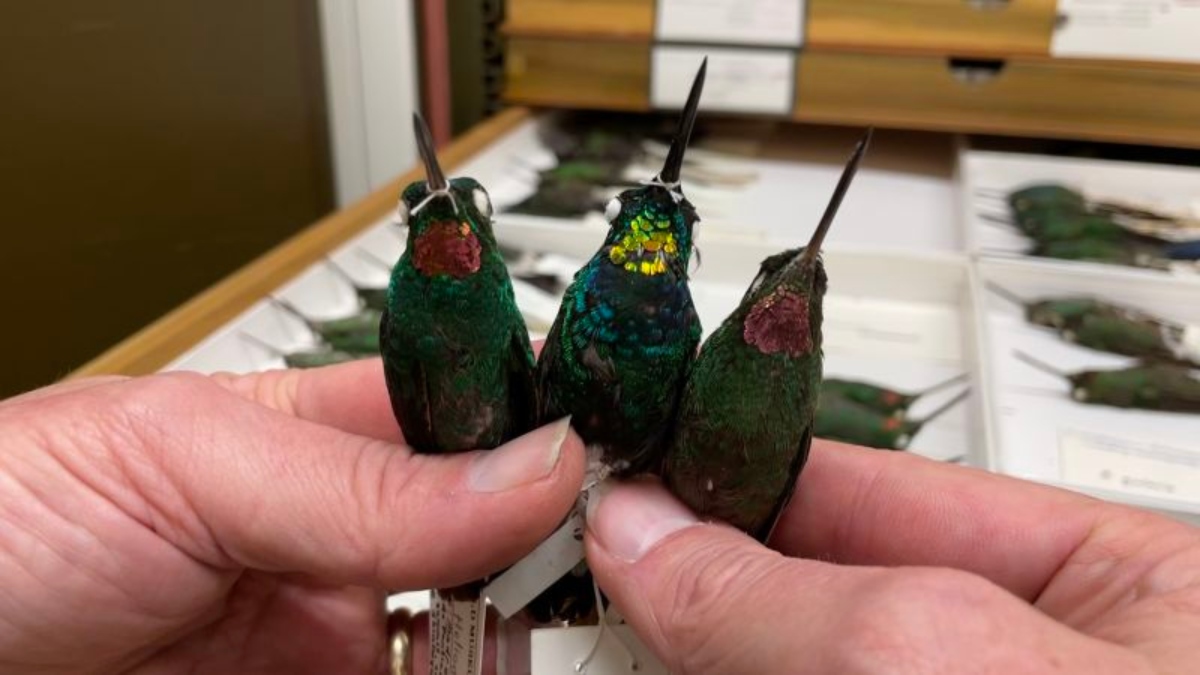Ecuador has a new species of hummingbird 0:42
(CNN) --
When researchers found a hummingbird sporting brilliant golden neck feathers in Peru's Cordillera Azul National Park, they thought it was a newly discovered species.
Part of an outer ridge on the eastern slopes of the Andes Mountains, the park is an isolated place: the perfect place to find a genetically distinct species.
They discover in Brazil a new species of a nice but poisonous toad
"I looked at the bird and said to myself, 'This thing doesn't look like anything else.' My first thought was that it was a new species," said John Bates, curator of birds at Chicago's Field Museum, in a release.
After concluding their fieldwork in Peru and returning to the Field Museum to perform DNA analysis on the bird, the researchers made a startling discovery.
The researchers set up a field laboratory in Peru's Cordillera Azul National Park, where the hybrid bird was found.
(Credit: John Bates/Field Museum)
The bird had never been documented before, but it was a hybrid resulting from two related hummingbird species: the rosy-throated glossy hummingbird, Heliodoxa gularis, and the rufous webbed glossy hummingbird, Heliodoxa branickii.
advertising
Both hummingbird species are known to have distinctly pink throat feathers, leading researchers to wonder how pink mixed with pink could result in golden feathers.
“We thought it would be genetically distinct, but it did match Heliodoxa branickii in some markers, one of the rosy-throated hummingbirds from that general area of Peru,” Bates said.
Initial DNA analysis focused on mitochondrial DNA, which is passed on from the mother's side, and matched Heliodoxa branickii.
Some female hummingbirds that look like males face less social harassment
The researchers then looked at nuclear DNA, the result of genetic contributions from both of the bird's parents, revealing aspects of Heliodoxa branickii and Heliodoxa gularis.
However, the golden-throated hummingbird was not the result of an even genetic split.
One of its ancestors was probably an even mix of the two species, while later generations appeared to have mated with branickii hummingbirds.
A study detailing the findings was published Wednesday in the Royal Society Open Science journal.
Since it's rare for hummingbirds of the same species to have such different throat feathers, the researchers delved deeper into the mystery of the golden feathers in hybrid species.
"It's a bit like cooking: if you mix salt and water, you know what you're going to get, but mixing two complex recipes could give more unpredictable results," study co-author Chad Eliason, a senior research scientist at the Field Museum, said in a statement.
"This hybrid is a mix of two complex recipes for a feather from its two parent species."
The hybrid bird's golden feathers come from genetic material provided by its two parent species, H. gularis (left) and H. branickii (right) (Credit: Kate Golembiewski/Field Museum)
The base color of feathers comes from pigment, such as melanin, but the structure of the feather cells and the way light reflects off the feathers create structural color.
It is this structural color that results in the iridescent nature of hummingbird feathers.
The research team studied the bird's throat feathers using an electron microscope to measure how light bouncing off the feathers creates different colors.
This is how they discover new species in Patagonia (before they become extinct)
“There is more than one way to make magenta iridescent,” Eliason said.
"Each of the parent species has its own way of making magenta, which is, I think, why you can get this non-linear or surprising result when you mix those two recipes together to produce a feather color."
The discovery suggests that hybrids may contribute to the rainbow of colors that appear in different hummingbirds.
"Based on the rate of color evolution observed in hummingbirds, we calculate that it would take 6 (million to) 10 million years for this dramatic pink-gold color change to evolve in a single species," Eliason said.
The researchers hope their work will inspire others to keep an eye out for possible hybrid hummingbird species, Bates said.
"New tools, such as genetic data, open up a new understanding of how these events occur across geography and time," Bates said.
"One question we want to investigate in the region of Peru where this study was conducted is how this complex piedmont landscape has evolved over time and what role those changes have played in the diversification of birds and other organisms."
hummingbird















